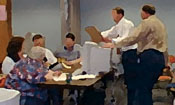

Appendix A - Survey to Assess School Commitment to Reasoning
The first step in using this survey is for the school council or faculty to fill it out as an expression of aspirations. What would the answers be if the school was doing a thorough and exemplary job of teaching for reasoning? Once those responses have been compiled and discussed, the next step is to gather descriptive data that accurately portrays actual practice. If there is a significant gap between desired commitment and actual delivery, the school council may work on ways to close the gap.1. What percentage of the items on ditto sheets or worksheets being used in connection with each of the following programs require synthesis (inventive thinking), analysis (investigatory thinking) or evaluation (decision-making)?
Science
___ per cent Social Studies
___ per cent Math
___ per cent Reading
___ per cent Health
___ per cent 2. What percentage of the questions suggested by the teacher's guide used in connection with each of the following programs require synthesis (inventive thinking), analysis (investigatory thinking) or evaluation (decision-making)?
Science
___ per cent Social Studies
___ per cent Math
___ per cent Reading
___ per cent Health
___ per cent 3. What percentage of the questions asked by the teachers during classroom discourse require synthesis (inventive thinking), analysis (investigatory thinking) or evaluation (decision-making)?
___ 0-10 per cent
___ 11-20 per cent
___ 21-40 per cent
___ 41-60 per cent
___ 60+ per cent
4. How often would students say they are challenged to work with raw data, converting it first to information (by seeking patterns and relationships) and then into insight (by determining the implications of the information)?
___ never
___ occasionally
___ monthly
___ weekly
___ daily
5. How often would students say they are challenged to invent, to solve problems and think imaginatively?
___ never
___ occasionally
___ monthly
___ weekly
___ daily
6. What percentage of exams, quizzes and unit tests requires higher level thinking (analysis, synthesis, evaluation)?
___ 0-10 per cent
___ 11-20 per cent
___ 21-40 per cent
___ 41-60 per cent
___ 60+ per cent